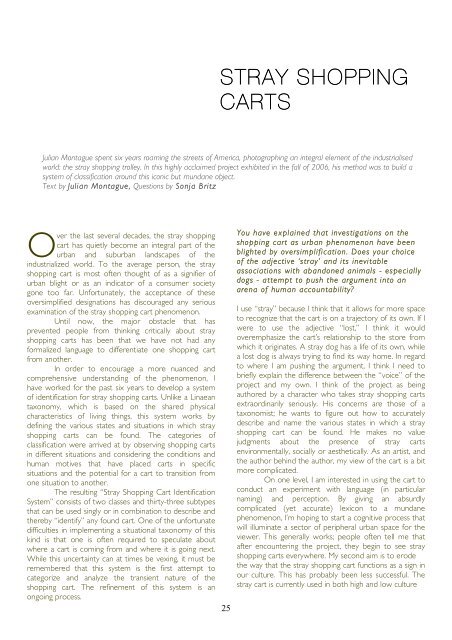M - Antennae The Journal of Nature in Visual Culture
M - Antennae The Journal of Nature in Visual Culture
M - Antennae The Journal of Nature in Visual Culture
You also want an ePaper? Increase the reach of your titles
YUMPU automatically turns print PDFs into web optimized ePapers that Google loves.
O<br />
ver the last several decades, the stray shopp<strong>in</strong>g<br />
cart has quietly become an <strong>in</strong>tegral part <strong>of</strong> the<br />
urban and suburban landscapes <strong>of</strong> the<br />
<strong>in</strong>dustrialized world. To the average person, the stray<br />
shopp<strong>in</strong>g cart is most <strong>of</strong>ten thought <strong>of</strong> as a signifier <strong>of</strong><br />
urban blight or as an <strong>in</strong>dicator <strong>of</strong> a consumer society<br />
gone too far. Unfortunately, the acceptance <strong>of</strong> these<br />
oversimplified designations has discouraged any serious<br />
exam<strong>in</strong>ation <strong>of</strong> the stray shopp<strong>in</strong>g cart phenomenon.<br />
Until now, the major obstacle that has<br />
prevented people from th<strong>in</strong>k<strong>in</strong>g critically about stray<br />
shopp<strong>in</strong>g carts has been that we have not had any<br />
formalized language to differentiate one shopp<strong>in</strong>g cart<br />
from another.<br />
In order to encourage a more nuanced and<br />
comprehensive understand<strong>in</strong>g <strong>of</strong> the phenomenon, I<br />
have worked for the past six years to develop a system<br />
<strong>of</strong> identification for stray shopp<strong>in</strong>g carts. Unlike a L<strong>in</strong>aean<br />
taxonomy, which is based on the shared physical<br />
characteristics <strong>of</strong> liv<strong>in</strong>g th<strong>in</strong>gs, this system works by<br />
def<strong>in</strong><strong>in</strong>g the various states and situations <strong>in</strong> which stray<br />
shopp<strong>in</strong>g carts can be found. <strong>The</strong> categories <strong>of</strong><br />
classification were arrived at by observ<strong>in</strong>g shopp<strong>in</strong>g carts<br />
<strong>in</strong> different situations and consider<strong>in</strong>g the conditions and<br />
human motives that have placed carts <strong>in</strong> specific<br />
situations and the potential for a cart to transition from<br />
one situation to another.<br />
<strong>The</strong> result<strong>in</strong>g “Stray Shopp<strong>in</strong>g Cart Identification<br />
System” consists <strong>of</strong> two classes and thirty-three subtypes<br />
that can be used s<strong>in</strong>gly or <strong>in</strong> comb<strong>in</strong>ation to describe and<br />
thereby “identify” any found cart. One <strong>of</strong> the unfortunate<br />
difficulties <strong>in</strong> implement<strong>in</strong>g a situational taxonomy <strong>of</strong> this<br />
k<strong>in</strong>d is that one is <strong>of</strong>ten required to speculate about<br />
where a cart is com<strong>in</strong>g from and where it is go<strong>in</strong>g next.<br />
While this uncerta<strong>in</strong>ty can at times be vex<strong>in</strong>g, it must be<br />
remembered that this system is the first attempt to<br />
categorize and analyze the transient nature <strong>of</strong> the<br />
shopp<strong>in</strong>g cart. <strong>The</strong> ref<strong>in</strong>ement <strong>of</strong> this system is an<br />
ongo<strong>in</strong>g process.<br />
STRAY SHOPPING<br />
CARTS<br />
Julian Montague spent six years roam<strong>in</strong>g the streets <strong>of</strong> America, photograph<strong>in</strong>g an <strong>in</strong>tegral element <strong>of</strong> the <strong>in</strong>dustrialised<br />
world: the stray shopp<strong>in</strong>g trolley. In this highly acclaimed project exhibited <strong>in</strong> the fall <strong>of</strong> 2006, his method was to build a<br />
system <strong>of</strong> classification around this iconic but mundane object.<br />
Text by Julian Montague, Questions by Sonja Britz<br />
25<br />
You have expla<strong>in</strong>ed that <strong>in</strong>vestigations on the<br />
shopp<strong>in</strong>g cart as urban phenomenon have been<br />
blighted by oversimplification. Does your choice<br />
<strong>of</strong> the adjective ‘stray’ and its <strong>in</strong>evitable<br />
associations with abandoned animals - especially<br />
dogs - attempt to push the argument <strong>in</strong>to an<br />
arena <strong>of</strong> human accountability?<br />
I use “stray” because I th<strong>in</strong>k that it allows for more space<br />
to recognize that the cart is on a trajectory <strong>of</strong> its own. If I<br />
were to use the adjective “lost,” I th<strong>in</strong>k it would<br />
overemphasize the cart’s relationship to the store from<br />
which it orig<strong>in</strong>ates. A stray dog has a life <strong>of</strong> its own, while<br />
a lost dog is always try<strong>in</strong>g to f<strong>in</strong>d its way home. In regard<br />
to where I am push<strong>in</strong>g the argument, I th<strong>in</strong>k I need to<br />
briefly expla<strong>in</strong> the difference between the “voice” <strong>of</strong> the<br />
project and my own. I th<strong>in</strong>k <strong>of</strong> the project as be<strong>in</strong>g<br />
authored by a character who takes stray shopp<strong>in</strong>g carts<br />
extraord<strong>in</strong>arily seriously. His concerns are those <strong>of</strong> a<br />
taxonomist; he wants to figure out how to accurately<br />
describe and name the various states <strong>in</strong> which a stray<br />
shopp<strong>in</strong>g cart can be found. He makes no value<br />
judgments about the presence <strong>of</strong> stray carts<br />
environmentally, socially or aesthetically. As an artist, and<br />
the author beh<strong>in</strong>d the author, my view <strong>of</strong> the cart is a bit<br />
more complicated.<br />
On one level, I am <strong>in</strong>terested <strong>in</strong> us<strong>in</strong>g the cart to<br />
conduct an experiment with language (<strong>in</strong> particular<br />
nam<strong>in</strong>g) and perception. By giv<strong>in</strong>g an absurdly<br />
complicated (yet accurate) lexicon to a mundane<br />
phenomenon, I’m hop<strong>in</strong>g to start a cognitive process that<br />
will illum<strong>in</strong>ate a sector <strong>of</strong> peripheral urban space for the<br />
viewer. This generally works; people <strong>of</strong>ten tell me that<br />
after encounter<strong>in</strong>g the project, they beg<strong>in</strong> to see stray<br />
shopp<strong>in</strong>g carts everywhere. My second aim is to erode<br />
the way that the stray shopp<strong>in</strong>g cart functions as a sign <strong>in</strong><br />
our culture. This has probably been less successful. <strong>The</strong><br />
stray cart is currently used <strong>in</strong> both high and low culture












